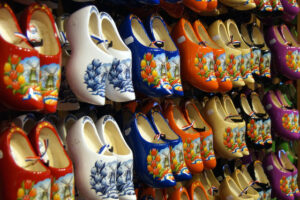
Dutch clogs are deeply rooted in traditional culture and often feature exquisite handiwork and decoration.
Clogs, or wooden shoes, have been used by many different cultures since the Medieval period. In Japan, clogs known as geta are still in use as part of traditional kimono dress. In some parts of rural Spain, albarcas are still worn by farmers. But perhaps no clogs are as famous as those from the Netherlands, known in Dutch as klompen. Dutch clogs are deeply rooted in traditional culture and often feature exquisite handiwork and decoration. While originally designed with practicality in mind, these days the average Dutch person sees klompen not as something to be worn, but rather as a proud expression of Dutch heritage.
Designed for Foot Protection
Clogs in the Netherlands dates back to the early 13th century. In those days, workers, tradesmen, and farmers needed shoes that would protect their feet from injury. Originally these clogs were designed with a wooden sole and a leather top – a design that was not very protective, especially when factories began springing up in Dutch cities. Soon, the entire shoe was carved from wood, usually willow or poplar wood. These shoes offered superior protection and allowed farmers to navigate muddy fields more easily. The klompen would even have different designs to suit the needs of individual professions. Soon after this, the Dutch began using clogs around the house – and eventually, more ornately designed clogs would be worn to churches and special occasions like weddings. In fact, at one point, it was customary for men to propose to their fiancé with a pair of clogs!
How Dutch Clogs are Made
Traditionally, a Dutch clog maker would take a hunk of wood and dip it into water to prevent splintering. Then, they would use a specially designed axe to shape the wood into the form of a shoe before using a sharp knife to fine-tune the outside, then hollow it out. The shoe would then sit to dry for about three weeks, then the artisan would hand-paint a design on the outside.
Today, modern machines have sped up the process of clog-making greatly. A machine carves the shoe shape uniformly, and all 12 official clog makers in the Netherlands have their own unique design. If you want to purchase a pair during your visit to the Netherlands, you can find traditional clog shops in every major city in the country. Better yet, consider a visit to Zaanse Schans – it’s usually cited as one of the best tourist sites in the Amsterdam area as it showcases much of traditional Dutch culture. It includes a clog workshop where you can watch artisans make the clogs in person!
Explore the World with AESU!
Are you ready to plan an adventure of a lifetime? AESU offers unique, thrilling travel programs for college students and young professionals at affordable rates. Each trip is action-packed and informal—designed just for people your own age. We are also able to design custom tours just for your group.
Experience an exhilarating adventure in 2023 on the Cosmopolitan, Great Escape, Greek Island Hopper tour, and more! 2023 tour dates are now available! If you have any questions or want help booking your next adventure, please contact AESU by calling 800-638-7640, or fill out the contact form found on our website. Follow AESU on Facebook, Twitter, Instagram, LinkedIn, and Pinterest.
